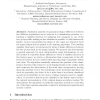Free Online Productivity Tools
i2Speak
i2Symbol
i2OCR
iTex2Img
iWeb2Print
iWeb2Shot
i2Type
iPdf2Split
iPdf2Merge
i2Bopomofo
i2Arabic
i2Style
i2Image
i2PDF
iLatex2Rtf
Sci2ools
IPMI
2001
Springer
2001
Springer
Deformation Analysis for Shape Based Classification
Statistical analysis of anatomical shape differences between two different populations can be reduced to a classification problem, i.e., learning a classifier function for assigning new examples to one of the two groups while making as few mistakes as possible. In this framework, feature vectors representing the shape of the organ are extracted from the input images and are passed to the learning algorithm. The resulting classifier then has to be interpreted in terms of shape differences between the two groups back in the image domain. We propose and demonstrate a general approach for such interpretation using deformations of outline meshes to represent shape differences. Given a classifier function in the feature space, we derive a deformation that corresponds to the differences between the two classes while ignoring shape variability within each class. The algorithm essentially estimates the gradient of the classification function with respect to node displacements in the outline mes...
Anatomical Shape Differences | Classifier Function | IPMI 2001 | Medical Imaging | Shape Variability |
| Added | 16 Nov 2009 |
| Updated | 16 Nov 2009 |
| Type | Conference |
| Year | 2001 |
| Where | IPMI |
| Authors | Polina Golland, W. Eric L. Grimson, Martha Elizabeth Shenton, Ron Kikinis |
Comments (0)

